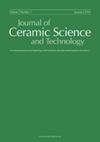通过β - α方石石变换的重复循环的迟滞
IF 0.4
4区 材料科学
Q4 MATERIALS SCIENCE, CERAMICS
引用次数: 7
摘要
通过差示扫描量热法(DSC)研究了方石英中β -to- α的转变,以解决反复热循环时焓、转变滞后和转变开始温度的变化。方石英粉在190 - 280℃之间反复循环,在高温立方方石和低温四边形方石之间进行第一次位移转换。在1560±27 J/mol时的放热焓大于1260±8 J/mol时的放热焓。随着相变的反复循环,相变起始温度和滞后量有系统地变化。随着循环的增加,β - α相变的起始温度呈对数增长,导致过冷性和迟滞性降低。α - β相变的起始温度随着循环次数的增加呈对数递减,过热现象和迟滞现象减少。迟滞降低表明转化障碍降低。我们认为,这种减少的迟滞表明,在β到α转变过程中-4.9%的体积变化引起的微断裂导致了颗粒细化。粉末粒度依赖性的观察支持了这一点。颗粒小于38 μm的粉末在循环过程中没有变化,说明38 μm低于临界最小粒径。本文章由计算机程序翻译,如有差异,请以英文原文为准。
Hysteresis upon Repeated Cycling through the Beta-Alpha Cristobalite Transformation
Beta-to-alpha transformation in cristobalite was examined by means of differential scanning calorimetry (DSC) to address how enthalpy, transformation hysteresis, and transformation onset temperature change upon repeated thermal cycling. Cristobalite powder was repeatedly cycled from 190 – 280 °C and back, cycling through the firstorder displacive transformation between high-temperature, cubic beta-cristobalite and low-temperature, tetragonal alpha-cristobalite. The enthalpy of the transformation did not changewith cycling, but the exothermic beta-to-alpha enthalpy at 1560 ± 27 J/mol was larger than endothermic alpha-to-beta enthalpy at 1260 ± 8 J/mol. Transformation onset temperatures and hysteresis varied systematically with repeated cycling of the transformation. The onset temperature of the beta-to-alpha transformation increased logarithmically with cycling, resulting in reduced undercooling and hysteresis. The onset temperature of the alpha-to-beta transformation decreased logarithmically with cycling, resulting in reduced super-heating and hysteresis. The reduced hysteresis indicates a lowered barrier to transformation. We propose this reduced hysteresis indicates particle refinement through microfracture caused by the -4.9% volume change on the beta-to-alpha transformation. This is supported by the observation of powder size dependence. Powder with particles finer than 38 μmhad no change on cycling, suggesting 38 μm is below the critical minimum size.
求助全文
通过发布文献求助,成功后即可免费获取论文全文。
去求助
来源期刊

Journal of Ceramic Science and Technology
MATERIALS SCIENCE, CERAMICS-
CiteScore
0.80
自引率
0.00%
发文量
0
期刊介绍:
The Journal of Ceramic Science and Technology publishes original scientific articles on all topics of ceramic science and technology from all ceramic branches. The focus is on the scientific exploration of the relationships between processing, microstructure and properties of sintered ceramic materials as well as on new processing routes for innovative ceramic materials. The papers may have either theoretical or experimental background. A high quality of publications will be guaranteed by a thorough double blind peer review process.
 求助内容:
求助内容: 应助结果提醒方式:
应助结果提醒方式:


